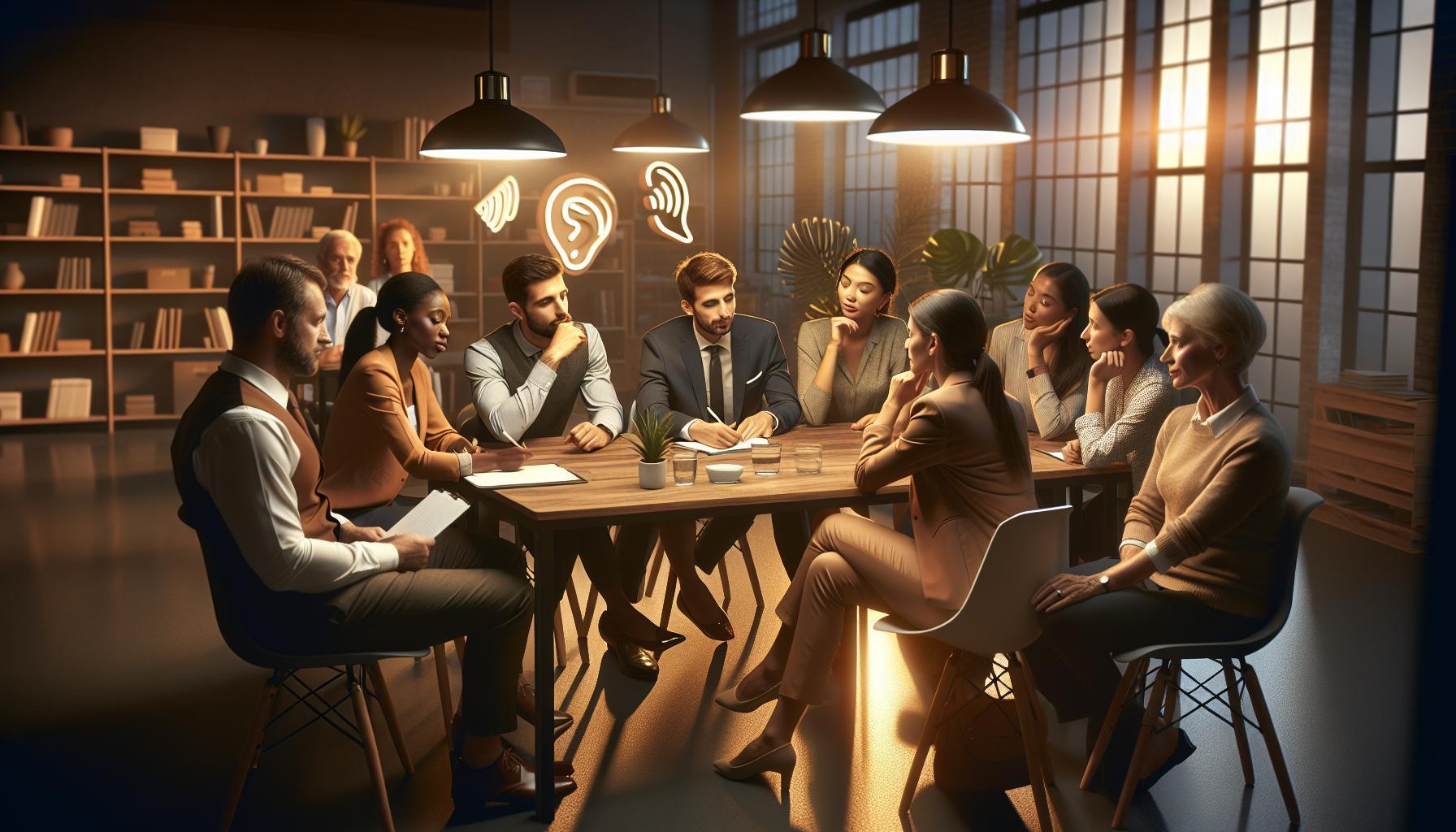Effective listening is a cornerstone of successful communication, yet many of us struggle with it daily. Did you know that active listening can significantly enhance your relationships, both personal and professional? By mastering a simple acronym that outlines essential listening skills, you can transform interactions into meaningful dialogues, fostering better understanding and trust.
Imagine being the person others turn to, knowing you genuinely hear and value their thoughts. This is not just a desirable trait; it’s a skill you can cultivate. The steps outlined in this guide will not only help you remember key listening behaviors but will also equip you to respond thoughtfully, navigate challenging conversations, and create an inclusive environment where everyone feels heard.
Dive into this article to discover practical techniques and actionable insights that will empower you to become a more effective listener. Enhance your communication abilities and watch as your relationships deepen and your professional interactions flourish. Your journey toward becoming a better communicator starts here!
Understanding the Importance of Listening Skills in Communication
In the realm of effective communication, listening skills hold a pivotal position. They serve as the foundation for understanding, fostering collaboration, and building relationships. When individuals genuinely listen, they validate the speaker’s feelings and perspectives, which enhances trust and openness in conversations. Moreover, strong listening abilities can prevent misunderstandings that often lead to conflicts. Engaging with others through active listening not only enhances the quality of interactions but also empowers individuals to connect more deeply, making it essential in both personal and professional contexts.
To cultivate superior listening skills, it’s important to adopt a multi-faceted approach. One practical method is to utilize the acronym “LISTEN,” which emphasizes key behaviors essential for effective listening. By remembering these steps-Look, Inquire, Stay engaged, Take notes, Empathize, and Navigate-the process becomes a manageable and recallable framework that can be applied in various situations. Engaging fully in conversations, asking clarifying questions, and providing feedback ensures that the listener not only hears the words being spoken but understands the meaning behind them.
Building proficiency in listening also requires awareness of potential barriers that can diminish effectiveness. Common obstacles include distractions, preconceived notions, and emotional reactions. Recognizing these barriers allows individuals to adjust their behaviors and create a more conducive environment for communication. For instance, eliminating external distractions and focusing on the speaker can significantly enhance comprehension and connection. By approaching conversations with an open mind and a willingness to understand, individuals can overcome these hurdles and improve their overall communication skills.
Ultimately, mastering listening is a valuable investment in personal and professional development. Practicing active and empathetic listening fosters strong relationships, enhances collaboration, and ensures that all participants feel heard and respected. Regular self-assessment of one’s listening skills can identify strengths and areas for growth, making it easier to implement effective strategies tailored to individual needs. By prioritizing listening, you pave the way for richer interactions and deeper, more meaningful connections with others.
The Acronym Framework: Steps to Improve Listening

To effectively enhance your listening skills, remembering the acronym “LISTEN” can serve as a powerful guide. Each letter corresponds to a specific action that, when employed consciously, can transform the way you engage in conversations. By actively practicing these steps, you reinforce your ability to connect with others and comprehend their messages deeply.
- L – Look: Maintain eye contact with the speaker to show engagement and interest. This non-verbal cue helps convey that you value what they are saying.
- I – Inquire: Ask clarifying questions to demonstrate that you’re not just hearing words, but are actively trying to understand the message. Questions like “Can you elaborate on that?” often deepen the discussion.
- S – Stay engaged: Nod occasionally and give appropriate verbal acknowledgments, such as “I see” or “That makes sense.” This encourages the speaker and reinforces your attentiveness.
- T – Take notes: When applicable, jot down key points during significant conversations, especially in professional settings. This reinforces your memory and allows you to reference back during discussions.
- E – Empathize: Try to put yourself in the speaker’s position. This involves not just understanding their words, but also recognizing their emotions. You might say, “It sounds like you’re feeling really overwhelmed,” to validate their feelings.
- N – Navigate: Guide the conversation back on track if it diverges too much. This means steering the focus to ensure clarity and relevance, making the communication more productive.
By memorizing and applying the “LISTEN” framework, you empower yourself to transform even the most mundane exchanges into meaningful dialogues. For example, in a business meeting, utilizing these steps ensures all team members feel valued and heard, promoting openness and collaboration. Practicing this acronym regularly will instill these habits, resulting in more effective and empathetic communication, whether at home or in the workplace.
Breaking Down Each Step: Practical Techniques for Listening

Maintaining effective communication hinges on the ability to listen actively. By breaking down the steps outlined in the acronym “LISTEN,” individuals can cultivate a more enriching dialogue that fosters understanding and connection. Each component provides a specific approach that can be practiced and refined, paving the way for enhanced interactions in both personal and professional realms.
Look
When engaging with someone, maintaining eye contact is key. This simple act reveals your commitment to the conversation, making the other person feel acknowledged and respected. For instance, during a team meeting, consistently looking at your colleagues when they speak not only signals that you value their input but also reinforces a collaborative atmosphere.
Inquire
Asking clarifying questions encourages deeper exploration of the topic at hand. Use prompts like, “Can you tell me more about that?” or “What did you mean when you said…?” Such inquiries can uncover nuances and promote richer discussions. In a coaching scenario, for example, a manager who poses thoughtful questions can effectively draw out the opinions and insights of their team members, fostering a more inclusive environment.
Stay Engaged
Verbal and non-verbal affirmations fuel the conversation. Simple gestures like nodding or verbal cues such as “That’s interesting” not only show you’re present but can significantly motivate the speaker to share more. In everyday interactions, practicing these techniques can transform mundane exchanges into meaningful connections, reinforcing the value of active engagement.
Take Notes
In professional settings, jotting down key points serves multiple purposes: it aids memory retention, shows seriousness about the discussion, and offers a reference for future conversations. In customer service, for instance, taking notes during a call allows representatives to provide personalized service which enhances customer satisfaction.
Empathize
By putting yourself in the other person’s shoes, you not only grasp their words but also their emotions. Acknowledging feelings like, “I can see why that would be frustrating,” validates their experience and builds rapport. In therapeutic settings, this technique is crucial to help clients feel understood, promoting a safe space for open dialogue.
Navigate
Conversations can easily lose focus, so gently steering them back on track when necessary is vital. Utilize phrases like, “Let’s revisit the main point” or “Can we shift back to the earlier topic?” to maintain clarity. This skill is particularly useful in lengthy meetings where discussions may diverge.
In mastering these steps, individuals can transition from mere listeners to engaged participants in any conversation. Regular practice of these techniques will not only improve your communication skills but also empower others, creating a more dynamic and collaborative environment.
Recognizing Barriers to Effective Listening
Effective listening is often undermined by various barriers that can significantly hinder communication and understanding. Recognizing these barriers is the first step towards enhancing listening skills. A common obstacle is distractions, which can manifest as external noise, technological interruptions, or even internal thoughts that pull focus away from the speaker. For instance, in a busy office, loud conversations or ringing phones may prevent someone from fully engaging with a colleague’s presentation. To counteract this, find a quieter space or establish ‘no interruption’ signals during discussions, facilitating a more focused environment.
Another barrier stems from prejudgments about the speaker or the topic being discussed. When listeners come in with preconceived notions or biases, they may dismiss important information. For example, if a team member feels that a presenting colleague always has irrelevant ideas, they may tune out rather than critically assess the contributions. A powerful strategy to combat this issue is to practice open-mindedness, consciously setting aside biases when entering discussions, allowing for a more enriching exchange of ideas.
Emotional reactions also play a significant role in listening barriers. When listeners feel defensive or triggered by certain topics, their ability to receive and process information is compromised. For example, a manager might react negatively to feedback from a team member, which can shut down open dialogue. To navigate emotional reactions, it’s beneficial to cultivate emotional intelligence, recognizing when emotions may be influencing listening and taking a moment to pause and reflect before responding. Practicing deep breathing or positive affirmations before entering challenging conversations can help maintain a calmer state of mind.
Ultimately, overcoming these barriers takes practice and commitment. Consistently applying techniques to minimize distractions, fostering open-mindedness, and developing emotional intelligence can enhance listening effectiveness, thus enriching personal and professional interactions. Remember, the goal isn’t just to hear but to truly understand and connect with others.
Active Listening: Key Strategies to Engage Others
Active listening is more than just a passive act; it’s a skill that fosters deeper connections and enhances understanding in any conversation. Engaging actively with a speaker allows for a more enriching dialogue, where both parties feel valued and understood. One key strategy is to give your full attention to the speaker. This means putting away distractions, such as smartphones or laptops, and maintaining eye contact, which shows the speaker that you are genuinely interested in what they have to say. Nodding and using verbal affirmations, like “I see” or “That’s interesting,” further encourages the speaker and reinforces your engagement.
Moreover, asking open-ended questions can significantly deepen the conversation. Instead of simple yes-or-no questions, ask things like, “Can you tell me more about that?” or “How did that make you feel?” This not only helps clarify points but also demonstrates your investment in their narrative. Another powerful technique is to paraphrase what you’ve heard. For example, you might say, “So what you’re saying is…,” which not only confirms your understanding but also invites the speaker to elaborate or correct any misconceptions.
Practical Techniques for Engaging Others
- Minimize Interruptions: Create a conducive environment by reducing background noise and setting aside scheduled time for discussions.
- Be Mindful of Body Language: Make sure your non-verbal cues, like leaning slightly forward and maintaining an open posture, convey interest and receptiveness.
- Practice Patience: Allow the speaker to finish their thoughts without interjecting, which can help prevent misunderstandings.
- Summarize Regularly: Every few minutes, recap what has been discussed to ensure that both you and the speaker remain aligned.
By integrating these techniques into your conversations, you not only improve your listening skills but also promote a respectful and thoughtful exchange. Remember, active listening is a practice that evolves over time, and each interaction is an opportunity to refine this valuable ability. As you cultivate a habit of engaging with empathy and openness, you’ll find your connections becoming stronger and more meaningful in both your personal and professional life.
Empathetic Listening: Building Connections through Understanding
Empathetic listening is a powerful tool that can transform conversations and deepen connections. It goes beyond mere hearing; it requires an emotional investment in understanding another person’s feelings and experiences. By practicing this style of listening, you’re not only demonstrating care and concern but also fostering trust and openness in your interactions. When individuals feel heard at a profound level, they are more likely to share their thoughts and feelings freely, creating a richer dialogue.
One practical way to enhance empathetic listening is by engaging in reflective responses. For example, when a colleague expresses frustration about a work project, instead of simply offering solutions, try saying, “It sounds like you’re feeling overwhelmed by the deadlines. I can see why that would be challenging.” This approach validates their emotional state and encourages further sharing. Use non-verbal cues to signal your engagement-maintain eye contact, nod in agreement, and lean slightly forward, which shows that you’re fully present in the moment.
Another effective technique involves asking clarifying questions. Rather than jumping to conclusions, pose inquiries such as, “Can you explain what you meant by that?” or “How did that impact you?” This openness invites the speaker to elaborate, unlocking a deeper understanding of their perspective. Additionally, practicing patience is crucial; allow silence to fill the space momentarily after someone finishes speaking. This pause gives the individual time to reflect and respond, showcasing your respect for their thoughts.
Fostering empathetic listening can significantly enhance both professional and personal relationships. Consider creating a list of specific scenarios in which you can apply these techniques, whether in a family conversation, team meetings, or social gatherings. By incorporating these practices into your daily interactions, you’ll not only improve your listening abilities but also strengthen your connections with others, leading to more meaningful and impactful exchanges.
Feedback Techniques: Enhancing Clarity in Communication
Effective communication is not just about speaking clearly-it’s equally about receiving feedback well. Feedback techniques can significantly enhance clarity in communication by ensuring that both parties understand one another. Using constructive and thoughtful feedback not only minimizes misunderstandings but also engages the speaker, allowing for a more dynamic and productive conversation.
To cultivate effective feedback techniques, begin with active listening. This means fully concentrating on what the speaker is saying, without formulating your response while they speak. Once they have finished, you can paraphrase their main points by saying something like, “So, what you’re saying is…” This not only confirms your understanding but also shows that you value their input. Additionally, remember to ask open-ended questions that prompt elaboration, such as, “Can you share more about how that affected you?” This encourages further dialogue and clarifies any uncertainties.
It’s also essential to use specific feedback rather than general statements. Instead of saying, “That was good,” offer insights like, “I really appreciated how you outlined the main issues clearly; it made it easier to follow your thoughts.” This type of feedback is actionable and helps the speaker understand what they did well and where they can improve. In situations where criticism is necessary, frame it constructively by focusing on behaviors rather than personal attributes, thus delivering your insights in an empowering manner.
Finally, practice these techniques in various settings, from professional meetings to casual conversations with friends. For instance, during a team discussion, you might use feedback techniques to clarify a colleague’s idea, which can lead to richer collaborations. Track your progress by reflecting on conversations where you successfully employed these techniques and the positive outcomes they produced. By consistently applying effective feedback methods, you will not only improve your own communication skills but also foster a more open and engaging environment for those around you.
Practical Exercises to Develop Listening Skills
Listening is a skill that can profoundly enhance your relationships, both personal and professional, yet many neglect its importance. To develop effective listening skills, engaging in impactful exercises can significantly sharpen your abilities. Here are some practical exercises that will empower you to become a more attentive listener.
1. The ‘Summarize and Reflect’ Exercise
Find a partner and engage in a structured conversation where one person speaks for a set time (e.g., 5 minutes) about a topic of their choice. The listener must focus intently, avoiding distractions. After the speaker finishes, the listener summarizes what they heard, emphasizing key points and feelings expressed. This not only reinforces the listener’s retention but also provides the speaker with validation that their message was received clearly.
2. The ‘Active Listening Role-play’
In this exercise, participants can role-play different scenarios such as job interviews or personal conflicts. One person plays the speaker, while the other practices active listening techniques, such as maintaining eye contact, nodding, and asking clarifying questions. After the role-play, both partners discuss what worked well in terms of communication and areas for improvement. This setup fosters an understanding of how non-verbal cues contribute to effective listening.
3. The ‘Listening Journal’
Maintain a journal specifically for tracking your listening experiences. After conversations, jot down what you heard and how effectively you responded. Reflect on moments where you felt engaged versus when distractions took over. Over time, this self-assessment will reveal patterns in your listening habits, helping to identify areas that need more focus.
4. Group Discussions on Diverse Topics
Participate in group discussions on varied subjects where each person takes turns sharing their viewpoints. Encourage everyone to listen attentively without interrupting, followed by a round of summarizing what each person said. This collective practice enhances the ability to listen to different perspectives, strengthens understanding, and fosters a sense of community.
By incorporating these practical exercises into your routine, you can cultivate a deeper awareness and improved techniques for active listening. Enhanced listening skills not only create stronger bonds with others but also lead to richer, more meaningful conversations. Embrace these strategies, and watch as your communication improves in ways you may not have expected!
Real-world Scenarios to Practice Active Listening
Effective active listening can be enhanced through practical real-world scenarios that simulate everyday conversations. Engaging in these scenarios allows individuals to apply listening skills in various contexts, reinforcing their learning and confidence.
One valuable scenario could be a team meeting where group members discuss a project. In such a setting, participants can practice active listening by using techniques such as maintaining eye contact, nodding to signal understanding, and paraphrasing what others have said to confirm comprehension. Here’s how to approach this scenario:
- Listen attentively: Focus on the speaker and avoid multitasking.
- Ask clarifying questions: If something isn’t clear, ask follow-up questions to gain deeper insights.
- Summarize points: At the end of the discussion, summarize the main points to ensure everyone is on the same page.
Another scenario might involve a conflict resolution setting. This could take place between friends or colleagues who are having a disagreement. Here, active listening can significantly change the outcome of the conversation. Encourage participants to:
- Empathize: Show understanding of the other person’s feelings and perspectives, which helps to diffuse tension.
- Avoid interrupting: Allow the other person to express their thoughts completely before responding.
- Share reflections: After the other party has spoken, reflect back on what they’ve said to show you value their viewpoint.
In both scenarios, the use of real-life interactions can strengthen listening skills through practice and feedback. Engaging with friends or colleagues in these structured conversations not only helps in refining listening techniques but also fosters a culture of open communication and understanding. Taking proactive steps by participating in these scenarios regularly can enhance one’s ability to connect meaningfully with others, whether in personal relationships or professional settings.
Measuring Your Listening Skills: Self-assessment Techniques
Understanding your listening skills is a vital step toward becoming a more effective communicator. Self-assessment techniques can illuminate areas where you excel and where improvement is needed. One of the simplest methods is to reflect on past conversations. After a discussion, take a moment to evaluate how well you listened. Did you ask questions or paraphrase what the speaker said? Consider keeping a journal where you note instances from your daily interactions and rate your listening effectiveness, allowing you to track your progress over time.
Feedback from others is another powerful tool for self-assessment. Engage trusted friends, family, or colleagues in a candid conversation about your listening skills. Ask them to provide specific examples of when they felt heard or, conversely, when they felt ignored. This direct feedback can provide insights that may not be immediately obvious to you. You could also use structured self-assessment questionnaires available online that prompt you to grade your skills across several listening criteria, such as attention, empathy, and responsiveness.
Additionally, practicing the art of video or audio recording your conversations (with permission) can be enlightening. Listening to your own interactions helps identify verbal and non-verbal cues you may miss in real time. Take note of how often you interrupt, how well you ask questions, or how effectively you engage with the speaker. For a more organized approach, create a simple table to record your observations, noting down aspects like eye contact, nodding, and other non-verbal signals against your overall comfort and engagement levels.
Finally, consider implementing a regular self-check routine. Set aside a few moments after significant conversations to reflect on your performance as a listener. Utilizing the acronym framework for listening skills, which may include steps like “focus,” “understand,” and “respond,” can provide a structured method for improvement. The more you practice this routine, the closer you will get to mastering the art of effective listening, leading to enhanced personal and professional relationships.
The Role of Non-verbal Cues in Listening
Non-verbal cues significantly enhance the process of listening, acting as powerful indicators of understanding and engagement. Research suggests that up to 93% of communication effectiveness is determined by non-verbal signals, fundamentally impacting how messages are received. Maintaining eye contact, for instance, not only shows attentiveness but also encourages the speaker to express their thoughts openly. By actively nodding or using facial expressions that convey empathy, listeners can create a reassuring environment that fosters deeper dialogues.
Integrating non-verbal communication into your listening practice involves being mindful and observant. Here are some simple yet effective techniques:
- Posture: Sit or stand comfortably to convey openness. Leaning slightly forward can signal interest and engagement.
- Gestures: Use hand movements that align with your verbal communication to enhance your message and show enthusiasm.
- Facial Expressions: Exhibit appropriate reactions-smiling when appropriate or showing concern during serious discussions boosts connection.
Combining these techniques with the acronym framework for listening can solidify your skills. For instance, while focusing on the speaker, ensure your body language aligns with your intent to listen. This consistency will help you become a more effective communicator, reinforcing trust and rapport.
Recognition of non-verbal cues not only involves sending the right signals but also interpreting them from others. Being attuned to subtle signs, such as the speaker’s tone or pace, can offer critical insights into their feelings. Practicing this aspect can empower you further in both personal and professional conversations, enriching the exchange and developing a more profound understanding of the dialogue at hand.
Applying Listening Skills in Professional and Personal Settings
In both professional and personal interactions, the ability to listen effectively can significantly enhance the quality of communication. Active listening fosters deeper understanding, reduces conflicts, and builds trust in relationships. For instance, in a workplace setting, when team members feel heard during meetings, they are more likely to contribute ideas and collaborate effectively, leading to innovative solutions and improved morale. Similarly, in personal relationships, taking the time to listen attentively shows respect and care, which can strengthen bonds and promote emotional intimacy.
To apply listening skills effectively, consider utilizing the acronym framework as a practical guide. Here are some actionable steps to integrate into your conversations:
- Focus: Maintain your attention on the speaker. This may involve putting away electronic devices and making eye contact to show genuine interest.
- Clarify: When something is unclear, ask questions. Phrases like “Can you elaborate on that?” can help ensure you fully grasp the speaker’s message.
- Summarize: After the speaker has finished, summarize what you’ve heard. This not only demonstrates your engagement but also allows for any necessary corrections.
- Reflect: Acknowledge emotions expressed. Saying things like, “It sounds like you’re feeling frustrated,” helps validate the speaker’s feelings and encourages further discussion.
Employing these steps can transform routine conversations into meaningful exchanges, promoting understanding and collaboration. For example, during a performance review, an active listener can create a supportive atmosphere by focusing intently on the employee’s feedback, clarifying uncertainties, and reflecting on the emotions conveyed. This demonstrates commitment to not only the employee’s professional growth but also to a positive workplace culture.
Real-world scenarios can provide excellent practice for refining these skills. For instance, in a family setting, you might practice active listening during a discussion about weekend plans. Invite family members to share their ideas, and use the aforementioned steps to engage fully. Reflecting on the conversation afterward can promote a culture of open communication at home, making everyone feel valued and understood. By consistently practicing these techniques, you will build your listening competence, paving the way for richer, more effective interactions in all areas of your life.
Q&A
Q: What are some effective techniques to improve listening skills?
A: To improve your listening skills, focus on techniques such as summarizing what the speaker says, maintaining eye contact, and asking clarifying questions. Practice active listening by providing feedback and avoiding distractions. Incorporating these methods into daily conversations can enhance both personal and professional communication.
Q: Why is empathetic listening important in communication?
A: Empathetic listening is crucial as it builds trust and understanding between individuals. By genuinely trying to understand the speaker’s perspective and emotions, you foster deeper connections and enhance collaboration. This skill is especially valuable in conflict resolution and relationship building.
Q: How can I recognize barriers to effective listening?
A: Barriers to effective listening include external distractions, personal biases, and emotional responses. To overcome these, identify your specific challenges, such as multitasking or preconceived judgments. Focus on creating a conducive environment and remain open-minded to improve your listening proficiency.
Q: When should I apply active listening techniques?
A: Active listening techniques should be applied in all conversations, especially in conflict situations, negotiations, or when sharing sensitive information. This approach not only ensures you accurately understand the speaker but also demonstrates respect and validation, improving overall communication effectiveness.
Q: What role do non-verbal cues play in listening?
A: Non-verbal cues, such as body language, facial expressions, and gestures, significantly enhance listening by providing additional context to the spoken words. Being aware of these cues can help you interpret emotions and intentions better, leading to more effective and supportive communication.
Q: How do I assess my listening skills?
A: You can assess your listening skills through self-reflection or by seeking feedback from others. Consider recording conversations and evaluating how well you grasped the main points, or ask for input on your listening style. Regular self-assessment can pinpoint areas for improvement.
Q: What are common mistakes people make while listening?
A: Common mistakes include interrupting the speaker, formulating your response while they talk, and failing to pay attention due to distractions. Addressing these habits can significantly improve your listening skills and overall conversational quality.
Q: How can practical exercises enhance my listening skills?
A: Engaging in practical exercises, such as active listening drills or role-playing scenarios, can significantly enhance your skills. These exercises help simulate real conversations, allowing you to practice techniques like summarization and feedback in a controlled environment, leading to improved performance in actual situations.
In Conclusion
Improving your listening skills is essential for fostering better communication and understanding in every aspect of life. By applying the techniques you’ve learned through our acronym, you’ll strengthen relationships, enhance collaboration, and boost both personal and professional growth. Don’t wait-start practicing these steps today to unlock the power of effective communication!
To deepen your mastery, explore our articles on active listening techniques and discover how to evaluate and respond to messages effectively. For ongoing tips and resources, consider signing up for our newsletter, where you can receive valuable insights and tools straight to your inbox. If you have any questions or wish to share your experiences, please leave a comment below. Together, let’s build a community dedicated to improving communication skills!





